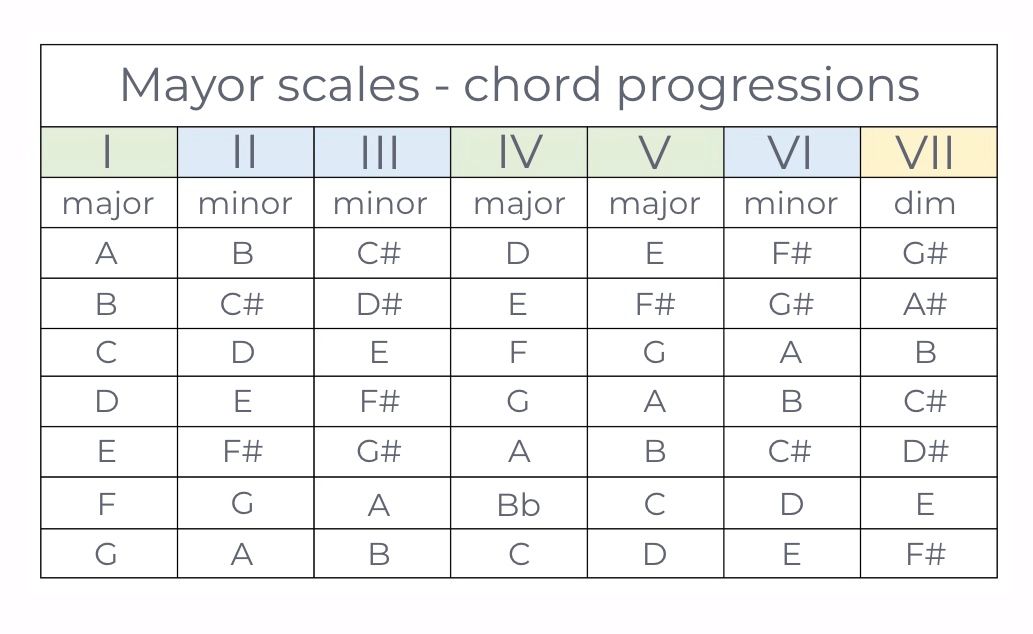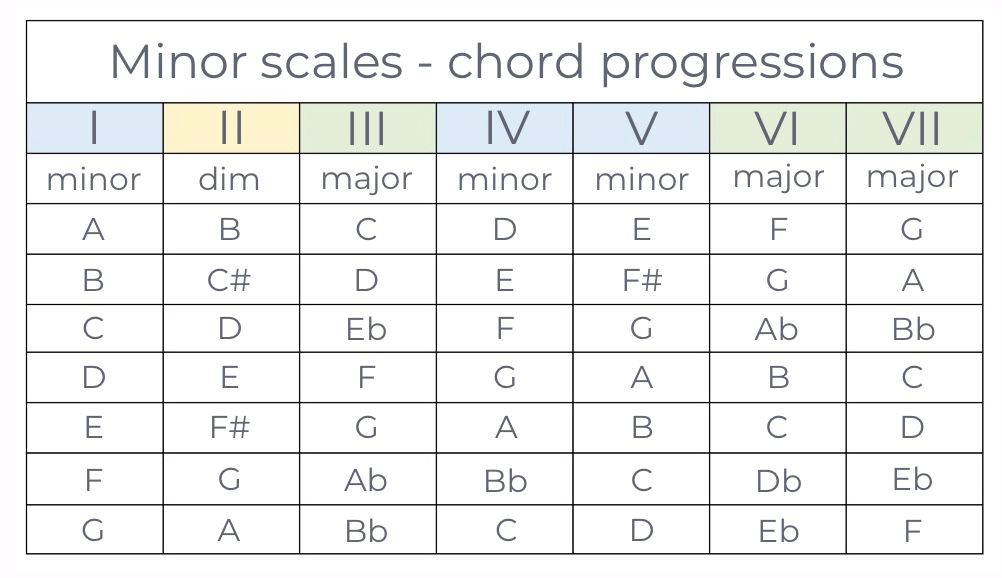The way we build a chord progression has a strong emotional and narrative power. In this article, discover how to enhance your ability to evoke desired emotions in your audience. (And if you're new to chords or need a refresher, explore our dedicated articles explaining what chords are and how to construct them).
What is a chord progression?
A chord progression is a sequence of chords in a song. These chords are often represented by Roman numerals and indicate the relationship between musical notes within a scale. While individual chords may not hold much narrative value, when combined in a progression, they can create specific emotional effects.
To understand chord progressions, it's important to grasp the scales they are based on. A scale consists of seven notes and an octave, labeled as I II III IV V VI VII. This means that a chord progression typically includes seven chords. Here's a simple rule:
- In major scales: The I-IV-V chords are major chords, the II-III-VI chords are minor chords, and the VII chord is diminished.
- In minor scales: The I-IV-V chords are minor chords, the II chord is diminished, and the III-VI-VII chords are major chords.
By understanding these basics, you'll be able to navigate the world of chord progressions, allowing you to create compositions that evoke powerful emotions and captivate listeners.
These images can help you visualize it all:


When crafting a chord progression, it's important to select chords that align with the desired emotion. Here's a simple guideline: if you want to project sadness, opt for a minor chord; for a sense of happiness, choose a major chord as the starting point. Remember, the first chord sets the tone and sets the stage for the audience's emotional experience.
💡 Explore our article on choosing key and modes to unlock the connection between chords and emotions.
The elements of chord progressions
Cadences, or chord progressions, encompass two crucial elements: direction and color.
What is direction in a chord progression?
Keep in mind that a chord progression aims resolve, or in other words to find its tonal centre. When a song lacks resolution or has a weak resolution, it leaves a sense of incompleteness, like an unfinished tale. This, in turn, can jeopardize the audience's connection with your music. Still, intentionally leaving a resolution unresolved is not necessarily a negative choice—it all depends on your intent.
To illustrate this, consider these examples of cadences with good resolutions:
- In a major key: (I) D - (IV) G - (V) A - (V7) A7
- In a minor key: (I) Em - (VII) D - (VI) C
Conversely, let's explore examples without clear resolutions:
- In a major key: (I) G - (III) B
- In a minor key: (I) Fm - (VI) Db
Play these progressions in your music notation software and you will understand what I am talking about:
A cadence does not necessarily have to resolve on the tonic, which is the most obvious and effective resolution. We can incorporate different chords in the progression that give direction without the need to resolve on the tonic. These chords are:
- In major: IV and V (with alterations such as adding the 7th or making the chord suspended) .
- In minor: IV, V (with alterations such as adding the 7th or making the chord suspended) and VII.
What is color in a chord progression?
Color adds depth and nuance to a song, making it captivating and dynamic. Certain chords have the ability to enhance the intended emotion. Consider incorporating these color-enhancing chords in your cadences:
- In major keys: II and III.
- In minor keys: III and VI.
Finding the right balance between color and direction is crucial for conveying the desired emotion in your song. Here are some cadence examples that I personally enjoy:
- In major keys: II-V-I / I-III-V-IV.
- In minor keys: I-VII-VI-IV / I-V-VI-VII.
A great tool to get some chord progression ideas for your song
Here you can access a resource that will assist you in exploring different combinations of chords. It's a practical and efficient way to overcome creative blocks and enhance your music-making process.
I really hope this information assists you in selecting the perfect cadence for your next composition in your music notation software.
And please join me for the final article in our series, "How to project emotions through music." We'll explore modulation, a powerful tool to gracefully change the emotional impact in a song, letting you discover how subtle shifts can add eloquence and depth to your music.
Thanks for reading!
If you liked this article, check out the other articles in this series:
- Music: A catalyst for emotions
- Choosing the right key
- Choosing the right tempo
- Creating a memorable melody
- Creating a powerful harmony
- Choosing the perfect chord progression
- The art of modulation
